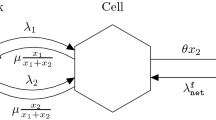Abstract
This paper investigates cellular mobile communications networks. The purpose of the paper is twofold. First, it is shown that the restrictive assumption of reversible routing is not required for the network population distribution to be of product form. Different protocols with their specific ways of handling congestion, all of them yielding product form, are discussed. Second, the notoriously difficult task of obtaining performance measures derived from product form expressions is attacked by an efficient method based on importance sampling. This algorithm substantially speeds up the computational time required to estimate, for example, the probability that a call attempting a hand‐over is blocked. In addition, qualitative insight is gained into the network conditional on blocking in a specific cell: are neighbouring cells overloaded as well? The examples include networks with capacity constraints due to effective interference between cells, and a reasonably sized network containing 49 cells and 7 cell reuse groups.
Similar content being viewed by others
References
S. Asmussen and R. Rubinstein, Steady state rare event simulation in queueing models and its complexity properties, in: Advances in Queueing: Theory, Methods and Open Problems, ed. J. Dshalalow (1995) pp. 429-462.
F. Baccelli and P. Brémaud, Elements of Queueing Theory: Palm-Martingale Calculus and Stochastic Recurrences (Springer, Berlin, 1994).
R.J. Boucherie, Batch routing queueing networks with jump-over blocking, Probability in the Engineering and Informational Sciences 10 (1996) 287-297.
R.J. Boucherie and N.M. van Dijk, Product forms for queueing networks with state-dependent multiple job transitions, Advances in Applied Probability 23 (1991) 152-187.
R.J. Boucherie and N.M. van Dijk, A generalization of Norton's theorem for queueing networks, Queueing Systems 13 (1993) 251-289.
R.J. Boucherie and N.M. van Dijk, On a queueing network model for cellular mobile communications networks, to appear in Operations Research.
J.A. Bucklew, Large Deviation Techniques in Decision, Simulation, and Estimation (Wiley, New York, 1990).
J.P. Buzen, Computational algorithms for closed queueing networks with exponential services, Communications of the ACM 16 (1973) 527-531.
K.M. Chandy, U. Herzog and L. Woo, Parametric analysis of queueing networks, IBM Journal of Research and Development 19 (1975) 36-42.
B.D. Choi, K.B. Choi and Y.W. Lee, M/G/1 retrial queueing systems with two types of calls and finite capacity, Queueing Systems 19 (1995) 215-229.
G.L. Choudhury, K.K. Leung and W. Whitt, An algorithm to compute blocking probabilities in multirate multi-class multi-resource loss models, Advances in Applied Probability 27 (1995) 1104-1143.
G. Colombo, Mobility models for mobile system design and dimensioning, ITC Specialists Seminar, Leidschendam, The Netherlands (1995).
D. Everitt, Product form solutions in cellular mobile communication systems, 4th Australian Teletraffic Research Seminar, paper No. 3.1 (1989).
D. Everitt, Traffic engineering of the radio interface for cellular mobile networks, Proceedings of the IEEE 82 (1994) 1371-1382.
D. Everitt and J. Evans, Traffic variability and effective interference for CDMA cellular networks, ITC Specialists Seminar, Leidschendam, The Netherlands (1995).
D. Everitt and N.W. Macfadyen, Analysis of multi-cellular mobile radiotelephone systems with loss, British Telecom Technical Journal 1 (1983) 218-222.
D. Everitt and D. Manfield, Performance analysis of cellular mobile communication systems with dynamic channel assignment, IEEE Journal on Selected Areas in Communications 7 (1989) 1172-1180.
G. Falin, A survey of retrial queues, Queueing Systems 7 (1990) 127-168.
P.W. Glynn and D.L. Iglehart, Importance sampling for stochastic simulations, Management Science 35 (1989) 1367-1392.
R. Guérin, Queueing-blocking system with two arrival streams and guard channels, IEEE Transactions on Communications 36 (1988) 153-163.
C. Harvey and C.R. Hills, Determining grades of service in a network, in: 9th Internat. Teletraffic Conf. (1979).
P. Heidelberger, Fast simulation of rare events in queueing and reliability models, ACM Transactions on Modeling and Computer Simulation 5 (1995) 43-85.
W. Henderson, C.E.M. Pearce, P.G. Taylor and N.M. van Dijk, Closed queueing networks with batch services, Queueing Systems 6 (1990) 59-70.
J.R. Jackson, Jobshop-like queueing systems, Management Science 10 (1963) 131-142.
J.S. Kaufman, Blocking in a shared resource environment, IEEE Transactions on Communications 9 (1981) 5-16.
J. Keilson and O.C. Ibe, Cutoff priority scheduling in mobile cellular communication systems, IEEE Transactions on Communications 43 (1995) 1038-1045.
F.P. Kelly, Reversibility and Stochastic Networks (Wiley, Chichester, UK, 1979).
F.P. Kelly, Loss networks, The Annals of Applied Probability 1 (1991) 319-378.
M. Mandjes, Fast simulation of blocking probabilities in loss networks, European Journal of Operational Research 101 (1997) 393-404.
D.L. Pallant and P.G. Taylor, Approximations of performance measures in cellular mobile networks with dynamic channel allocation, Telecommunication Systems 3 (1994) 129-163.
D.L. Pallant and P.G. Taylor, Modeling handovers in cellular mobile networks with dynamical channel allocation, Operations Research 43 (1995) 33-42.
J.W. Roberts, A service system with heterogeneous service requirements — applications to multi-service telecommunications systems, in: Proc. of Performance of Datacommunications Systems and Their Applications, ed. G. Pujolle (1981) pp. 423-431.
K. Ross and J. Wang, Monte-Carlo summation applied to product form loss networks, Probability in the Engineering and Informational Sciences 6 (1992) 323-348.
R.Y. Rubinstein, Simulation and the Monte-Carlo Method (Wiley, New York, 1981).
E. Seneta, Non-negative Matrices and Markov Chains (Springer, Berlin, 1981).
A. Shwartz and A. Weiss, Large Deviations for Performance Analysis (Chapman & Hall, London, 1995).
P. Tran-Gia and M. Mandjes, Modeling of customer retrial phenomenon in cellular mobile systems, IEEE Journal on Selected Areas in Communications 15 (1997) 1406-1414.
N.M. van Dijk, Queueing Networks and Product Forms: A Systems Approach (Wiley, Chichester, UK, 1993).
P. Whittle, Systems in Stochastic Equilibrium (Wiley, New York, 1986).
Author information
Authors and Affiliations
Rights and permissions
About this article
Cite this article
Boucherie, R.J., Mandjes, M. Estimation of performance measures for product form cellular mobile communications networks. Telecommunication Systems 10, 321–354 (1998). https://doi.org/10.1023/A:1019183404093
Issue Date:
DOI: https://doi.org/10.1023/A:1019183404093




